Acca sellowiana (Feijoa)
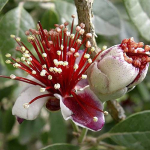
Acca sellowiana, commonly known as Pineapple Guava or Feijoa, is a small tree or shrub that is native to South America, particularly Brazil, Argentina, Paraguay, and Uruguay. It is also grown in other parts of the world, including New Zealand, Australia, and the United States.
The plant has thick, grayish-green leaves that are about 8cm long and 4cm wide. It produces showy, pink and white flowers that bloom in late spring to early summer. The flowers are followed by edible fruit that is oval-shaped, about 6cm long, and has a green, slightly rough exterior. The inside of the fruit is filled with a juicy, aromatic pulp that is white, cream-colored or pink. The pulp has a unique, sweet-tart flavor that is often described as a mix of pineapple, strawberry, and guava, which gives the plant its common names.
Acca sellowiana is a hardy plant that can tolerate a range of soil types and growing conditions, including drought and frost. It is commonly grown as an ornamental plant for its attractive foliage, flowers, and fruit. The fruit is also a popular ingredient in jams, jellies, desserts, and beverages. Acca sellowiana is the original feijoa which many of the new varieties have been bred from. Self-fertile.
Flowering: Spring [September - November]
Fruiting: Summer [December - January]
Aristotelia serrata (Makomako, Wineberry)
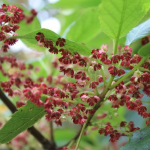
Aristotelia serrata, commonly called Makomako or Wineberry, is a fast-growing, small deciduous tree. Attractive rose-coloured flowers in spring. Deep red to black berries in summer are highly sought after by native birds. Good shade tree in sheltered areas. Frost-tender when young, however hardy once mature.
It has serrated, green leaves which may develop a purple hue, and typically grows to 5 m tall and 4 m wide. Wineberry is commonly used as a smaller specimen tree, trimmed into a hedge, or used for screening and shelter.
Best results with this tree are achieved when it is planted in full sun on a well-drained site. It will tolerate cool climates and moderate frost once established, as well as most soil conditions but only short periods of dry.
Habitat: Lowland to montane forests. Often forming dense thickets following disturbance.
Flowering: Spring [September - December]
Fruiting: Summer [November - February]
FoodSource for: Birds(F,S,N,O), Bees, Insects, Lizards
My Lists: Pioneer Species
Chamaecyparis pisifera Boulevard (Sawara Cypress)
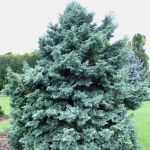
Chamaecyparis pisifera Boulevard is an attractive, semi-dwarf, evergreen conifer with a dense, upright and broadly pyramidal growth habit. It is a conical grower with soft, silvery blue-green awl-shaped leaves which are not prickly but curve nicely to a fine point along the compact branches.
Chamaecytisus palmensis (Tree Lucerne, Tagasaste)
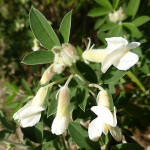
Tree Lucerne is a small, fast-growing tree, great for stock fodder, firewood or shelter. Attracts wood pigeons during winter and spring when it's in flower as well as bees attracted by the flowers too. It's also nitrogen fixing, drought tolerant and controls erosion with its deep roots. One of the best trees to attract tui and other native birds to your garden. Nurse crop for natives. Withstands drought/wind. Evergreen. Frost tender when young.
Habitat: Dry places, river beds, coastal sites, hillsides.
Flowering: Winter - Spring [May - October]
Fruiting:
My Lists: Winter Pollen
Coprosma lucida (Shining Karamu)
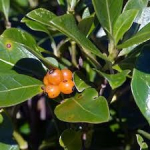
Coprosma lucida is endemic and commonly known as shining karamu. It is a small tree that is ideal for coastal projects. It can survive in many climates, but is most commonly found in coastal areas, lowland forests, or shrublands. It performs best where it can derive sufficient moisture and some shade, although it is tolerant of challenging locations such as coastal shrubland. Its wide, bright green leaves are thick, smooth, and shiny.
As with other Coprosma species, their berries are ideal for attracting birds, especially bellbirds, tuis and waxeye.
Habitat: Coastal and lowland forests or shrublands.
Flowering: Spring [August - December]
Fruiting: Summer [January - June]
Cordyline australis (Ti Kouka, Cabbage Tree)
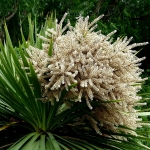
Cordyline australis, Ti Kouka, commonly called Cabbage Tree, is one of the most identifiable New Zealand native plants in the landscape. It has a tall straight trunk or trunks and a dense round head, with a sphere of long narrow leaves. Cabbage tree produces a profusion of attractive and scented flowers in spring. It is an abundant seeder. It looks most natural in the ornamental garden if planted in groups. Three or more plants can be planted together in the same hole to produce this effect. It grows in all soils and situations, even in swampy ground, where little else of interest will grow.
Cordyline australis is a light-demanding pioneer species, and seedlings die when overtopped by other trees. To grow well, young plants require open space so they are not shaded out by other vegetation. Its fruit and nectar are a favourite food source for kererū and tūī. Bellbirds like to nest in Tī Kōuka. Some lizards forage among the flowers of Cordyline australis and the nectar of the flowers is sought after by insects.
History of use: The Maoris obtained a most nutritious food, kauru, from the root of the young cabbage tree. This root is an extension of the trunk below the surface of the ground and is shaped like an enormous carrot some 2–3 ft long. An observer of the early 1840s, Edward Shortland, noted that the Maoris “prefer those grown in deep rich soil; they have learned to dig it at the season when it contains the greatest quantity of saccharine matter; that is, just before the flowering of the plant. They then bake, or rather steam it in their ovens. On cooling, the sugar is partially crystallised, and is found mixed with other matter between the fibres of the root, which are easily separated by tearing them asunder, and are then dipped in water and chewed”. The trunk of the cabbage tree is so fire-resistant that early European settlers used it to make chimneys for their huts. They also brewed beer from the root.
Medical Uses: An infusion of the leaves was used for dysentery and diarrhoea and for cuts. (From "Maori medical lore" by W. H. Goldie. 1905) The leaves were softened by rubbing and scraping. These scrapings were applied as an ointment to cuts, cracks in the skin and sores (from unpublished notes by Beryl Moore 1940). The younger inner shoots and the top of the stem were boiled and eaten by nursing mothers and were given to their children for colic. (From unpublished notes by T. Kururangi 1941)
Habitat: Widespread and common from coastal to montane forest. Most commonly encountered on alluvial terraces within riparian forest.
Flowering: Spring [October - December]
Fruiting: Summer - Autumn [January - April]
My Lists: Erosion Control, Wetland, Pioneer Species
Cupressus Ovensii (Ovens Cypress)
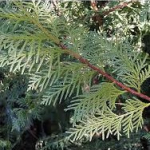
Cupressus Ovensii is a narrowly conical, evergreen conifer. Attractive, dark green, flattened foliage makes a great, dense hedge with trimming. Rapidly growing, with straight growth and canker resistance. Ideal for forestry, or trimmed shelter belt. Good timber, forms heart wood early. Grows approximately 7m tall after 5 years, and 30m when mature. Can be kept trimmed as low as 3m with annual pruning.
Full sun to part shade. Suits all soil types. Tolerant of strong winds but only some coastal exposure. Frost hardy.
Dacrycarpus dacrydioides (Kahikatea, White Pine)
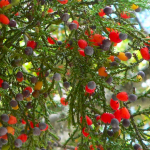
Dacrycarpus dacrydioides, commonly called kahikatea or white pine, is the tallest growing native tree, featuring handsome mature foliage and attractive buttressed roots. Best planted in moist to wet situations. The main tree species in Riccarton Bush. Edible fruit/seed from February to April is attractive to birds. On swampy sites Dacrycarpus dacrydioides develops buttresses for stability which extend to the roots. Not a garden tree. Ideal for revegetation planting, particularly in wetter areas and riparian projects. This native is frost-tolerant. Slow growing, loves fertile, swampy ground but can handle drier sites with good rainfall. Evergreen. Intolerant of heavy frosts.
Habitat: Lowland forest, formerly dominant on frequently flooded, and/or poorly drained alluvial soils. Occasionally extends into lower montane forest. Once the dominant tree of a distinct swamp forest type all but extinct in the North Island - the best examples remain on the West Coast of the South Island.
Flowering: Spring - Summer [October - January]
Fruiting: Autumn [February - April]
My Lists: Wetland
Discaria toumatou (Matagouri)
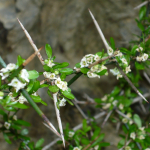
Discaria toumatou, commonly called Matagouri, is a tangle-branched, extremely thorny, divaricating shrub or small tree up to five metres tall. It has small leathery leaves close to the thorns, which are only abundant in spring or the shade. The flowers are tiny and white with no petals. It is the only New Zealand native plant that has thorns. Nitrogen-fixer. Common in dry shrublands of the eastern South Island.
It is most common in tussock grassland, stony areas and river beds. It is common in the eastern South Island, and found in a few coastal localities in the North Island south from the mouth of the Waikato River. As with other Discaria species it fixes nitrogen from the atmosphere with the help of symbiotic bacteria of the genus Frankia in its roots. It often grows in association with mingimingi (Coprosma propinqua), porcupine shrub (Melicytus alpinus, an alpine mahoe) and native brooms (Carmichaelia species). Seeds are dispersed by ballistic projection and water.
Matagouri plays an important ecological role in providing habitat and food sources for various native bird species, including silvereyes and bellbirds. The dense, spiny branches offer protection from predators and nesting sites for birds. Matagouri also helps stabilise the soil and prevent erosion in exposed and fragile environments.
As a native plant matagouri has complete protection on public conservation land and a degree of protection on private land under the Resource Management Act 1991. In a notable case a 400 ha area of matagouri forest, including trees that may have been 150 years old, was illegally sprayed at the head of Lake Sumner in 2001.
Habitat: Found in dry riverbeds, open rocky places and sand dunes from coastal to subalpine.
Flowering: Spring - Summer [October - January]
Fruiting: Summer [December - March]
Dodonaea viscosa (Ake Ake)
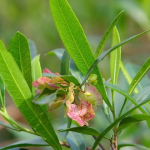
Dodonaea viscosa, commonly called Akeake, is an ornamental small bushy erect tree. Attractive brown flaky bark. The long shining leaves are bright green and dense on erect branches. The seed capsule is most attractive in the autumn. Wind resistant, and grows in coastal sites. Good for shelter in light sandy soils.
Habitat: Coastal to lowland forest, occupying a range of habitats from dunefields and boulder beaches through coastal scrub to lowland forest. Rarely forming a dominant tree in coastal forest.
Flowering: Spring - Summer [September - January]
Fruiting: Summer - Autumn [November - April]
Dodonaea viscosa Purpurea (Ake Ake Purpurea)
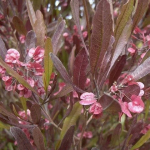
Dodonaea viscosa Purpurea, commonly called Ake Ake, is an ornamental small bushy erect tree. Attractive brown flaky bark. The long shining leaves are purple-red, intensifying in colour in winter. The seed capsule is most attractive in the autumn. Wind resistant, and grows in coastal sites. Good for shelter in light sandy soils. Very hardy for establishing in difficult soil.
Flowering: Spring - Summer [September - January]
Fruiting: Summer - Autumn [November - April]
Fuchsia excorticata (Kotukutuku, Tree Fuchsia)
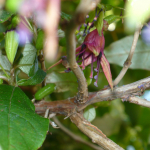 Sold Out
Sold Out
Fuchsia excorticata, also known as Kotukutuku, Tree Fuchsia, and New Zealand Fuchsia. Native to New Zealand and considered to be the worlds largest fuchsia. Attractive, small flowers begin to appear in mid spring. They are greenish-yellow then turn purple-red. followed by dark purple berries that are edible and tasting similar to tamarillo. It is easily recognised in its native environment by the characteristic appearance of its bark, which peels spontaneously, hanging in red papery strips to show a pale bark underneath. Plant in full sun or partial shade, hardy, semi-deciduous to deciduous.
Kōtukutuku is also a favoured food for bees. Other native trees that provide excellent food for honey bees and our own native bees (Leioproctus, Lasioglossum, and Hylaeus genera), are Psuedopanax arboreus, Cordyline australis, Schefflera digitata, Kunzea, and Pittosporum tenuifolium.
Habitat: Found in lowland and montane forests, especially along forest margins and streamsides where the soil is damp.
Flowering: Winter - Spring - Summer [July - January]
Fruiting: Summer [November - March]
My Lists: Winter Pollen
FoodSource for: Birds(F,S,N,O), Bees, Insects, Lizards
Fuscospora cliffortioides (Tewhai Rauriki, Mountain Beech)
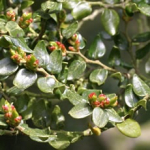
Fuscospora solandri var. cliffortioides is known as Mountain Beech because it is found at higher altitudes than Black Beech and can be found at various altitudes. It does not grow as tall as F. solandri and tolerates hard, dry infertile , poorly-drained sites in alpine areas. Differs from black beech by the finer leathery leaves with acute apices and obscure leaf venation. Although the two are closely allied and readily form hybrids, they are distinct species.
Habitat: Found in montane and subalpine forest and subalpine scrub. Often forming a dense, almost monospecific forest especially along the drier eastern side of the South Island.
Flowering: Summer [November - January]
Fruiting: Autumn [February - April]
Fuscospora fusca (Tawhai Raunui, Red Beech)
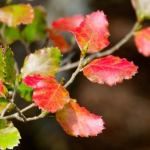
Fuscospora fusca, commonly called Red Beech, as a young tree has bright-red foliage during winter. Rapid early growth. Strong durable red wood. Can clip to a formal hedge. Suits a cool, moist, sheltered site with deep, well-drained soil. Evergreen.
Habitat: Found in lowland and montane forests.
Flowering: Spring [September - December]
Fruiting: Summer [November - March]
Fuscospora solandri (Tawhai Rauriki, Black Beech)
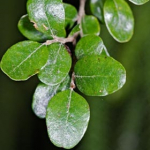
Fuscospora solandri, commonly called Black Beech, is a tall attractive tree with black bark and tough leathery leaves. Wind-hardier than other beeches. Suits moderately fertile, well-drained soils at low altitude in drier eastern areas. Evergreen.
At times Beech dominate the canopy, forming its own distinctive forest type. Often found in hardwood forest plant communities that include but are not limited to Aristotelia serrata, Pittosporum eugenioides, Pseudopanax arboreus, Podocarpus totara and Fuscospora cliffortioides among others. Differs from mountain beech by the oblong leaves with obtuse apices and obvious leaf venation. Although the two are closely allied and readily form hybrids, they are distinct species.
Known as black beech because it is prone to a sooty mould that covers the trunk and branches as a result of scale insect infestation. The insect secretes honeydew, feeding the mould and attracting birds and bees.
Habitat: Lowland to montane forest. At times the canopy dominant and forming its own distinctive forest type.
Flowering: Spring [September - December]
Fruiting: Summer [November - April]
Griselinia Broadway Mint (Broadleaf)
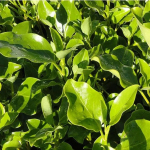
Griselinia Broadway Mint, a broadleaf native hybrid, is a must for any garden that needs a screen, private area, wind protection or just an attractive evergreen plant with glossy deep green slightly wavy edged leaves. It is quick to establish itself and requires little maintenance or attention to thrive. It can be planted in sun or shade and in moist free draining soils. Evergreen. Hardy.
Flowering: Summer [November - January]
Fruiting: Autumn [February - August]
Griselinia Canterbury (Kapuka, Broadleaf)
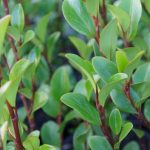
Griselinia Canterbury, commonly called Broadleaf, is a dependable, quick-growing shrub forming a dense, attractive hedge. Canterbury is known for its’ attractive dark red stems and finer rich-green foliage. Can be clipped and maintained into formal hedging to provide good colour and texture to your landscape. Tolerant of just about any planting conditions including coastal. Evergreen. Hardy.
Flowering: Summer [November - January]
Fruiting: Autumn [February - August]
Griselinia littoralis (Kapuka, Broadleaf)
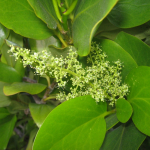
Griselinia littoralis, Kapuka or Broadleaf, is a very hardy evergreen tree. With regular trimming it makes a popular and effective hedging shrub. Grows in a range of soil types but prefers well-drained soil in full sun. Can tolerate frost and wind. It is useful in coastal situations (littoralis means shore growing) as it will tolerate frost, rough winds and salt spray. It is also a good upper bank plant for riparian plantings.
The oval leaves are leathery glossy and lush bright green. This plant produces small cream insignificant flowers that attract native pollinators. The tiny green and yellow flowers are also a good source of pollen for bees in the spring. In autumn the female trees have small purple-black fruit which tui eat.
History of use: It was an opening medicine and the inner bark was used on scrofula (a tuberculous infection of the skin on the neck). The timber was known for its durability.
Habitat: Found in lowland forests to subalpine scrub.
Flowering: Summer [November - January]
Fruiting: Autumn - Winter [February - August]
Hoheria angustifolia (Houhere, Narrow-leaved Lacebark)
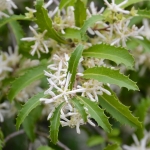
Hoheria angustifolia, Houhere, commonly known as Narrow-leaved Lacebark, is a tree native to New Zealand. It is a member of the family Malvaceae and is known for its striking appearance, with its slender leaves and attractive flowers. The leaves of Hoheria angustifolia are narrow and lanceolate.
The flowers of Hoheria angustifolia are one of its most distinctive features. They are typically large and showy, measuring 1.5-2 cm in diameter and arranged in clusters at the tips of the branches. The flowers are usually white and fragrant, and attract pollinators such as bees and butterflies.
The bark of Hoheria angustifolia is smooth and greyish-brown when young, becoming rougher and more fissured with age. The bark peels off in strips, revealing a lighter colored inner bark, which adds to its aesthetic appeal.
Hoheria angustifolia is primarily grown as an ornamental tree in gardens and parks, appreciated for its graceful form, attractive flowers, and interesting bark. It is also used in ecological restoration projects for its ability to attract pollinators and provide habitat for birds and insects.
History of use: The inner bark of Hoheria angustifolia has been used traditionally by Maori for making rope and twine.
Habitat: A common mostly lowland forest species frequenting alluvial forest where it may at times be dominant. Hoheria angustifolia is often an important host for taapia (Tupeia antarctica).
Flowering: Summer [December - March]
Fruiting: Autumn [February - April]
Kunzea ericoides (Kanuka)
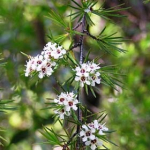
Kunzea ericoides, Kanuka tree, is a fast growing tree found throughout the north of the South Island. The leaves are softer to touch than Manuka and has smaller white flowers in Summer. It is very hardy, tolerating drought, frosts and poor soils. It is a primary colonising plant and used for revegetation as a nurse plant. Both manuka and kanuka are used as a nurse crop with other early colonizing plants for revegetation / restoration planting and are also very effective in erosion control. It is fast-growing, but short-lived, living up to 150 years. A juvenile takes about seven years to reach reproductive maturity. Very hardy.
History of use: The name "tea-tree" comes from the early bushman who used Manuka and Kanuka leaves to brew a drink similar to tea. Captain Cook was the first person to brew tea from manuka and said that it had a very agreeable, bitter taste when made with fresh leaves, but lost some of it piquancy when made with dry leaves. Kanuka leaves produce a tea that isn't quite as flavourful. Both tea-trees supposedly have medicinal uses and properties whose benefits far outweigh any considerations of taste. The leaves, brewed in water, help urinary complaints and reduced fevers.
The Maori and early settlers used to chew young shoots or swallow a drink made from seed capsules as a cure for dysentery and diarrhoea. The liquid from boiling the bark was used to treat constipation, as a sedative to promote sleep and reduce fever, for bathing sore eyes, treating colic, inflamed breasts, scalds and burns. The white gum was applied to scalds and burns and was taken by adults and children to relieve coughing. There are much more medicinal uses to which tea-tree was put to. Kanuka flowers produce a reasonable amount of nectar that is quite favoured by honeybees. The thick golden honey is hard to remove from honeycombs, but is quite popular for its strong taste and reputed antibacterial properties. Nowadays New Zealand’s monofloral Manuka and Kanuka pharmaceutical honey are both renowned for their natural health benefits.
The tough wood was used by Maori for implements such as fern root beater, mauls, paddles, weapons, spade blades, weeders, digging sticks and bird spears. The timber was noted for its straight grain, durability and strength by early European settlers, and was in demand for wheel-spokes, tool handles and other such purposes. Kanuka and Manuka wood is commonly used as firewood, especially for barbeques, or charred into charcoal. Older trees of have their trunks covered with a light brown bark that readily strips off, and is frequently used for fire-kindling. Both Manuka and Kanuka branches have been used to make brush brooms.
Habitat: Coastal to lowland shrubland, regenerating forest and forest margins, also present in montane forest, ultramafic shrubland and very occasionally present in subalpine shrubland.
Flowering: Spring - Summer [September - February]
Fruiting: Autumn [March - April]
My Lists: Erosion Control, Pioneer Species
(Taxonomists recently confirmed that K ericoides, K robusta, and K serotina are all the same species and declared all South Island Kānuka Kunzea ericoides.)
Melicytus ramiflorus (Mahoe, Whiteywood)
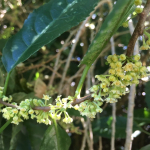 Sold Out
Sold Out
Melicytus ramiflorus, commonly known as Whiteywood or Mahoe, is one of our most common trees, found in forest and shrub throughout New Zealand and growing quickly to 5m or more. The pointed oval leaves are a bright green, with fresh growth being quite soft and an even brighter green. The bark is greyish white and becomes attractively mottled with lichens. Flowers in spring followed by numerous purple black berries. Whiteywood can be clipped for hedging or used as a shelter tree or filler, and will also make quite an attractive specimen. Avoid heavy frosts when young.
The berries of Māhoe are eaten by a number of native birds, including kererū and tui, and some geckos. It is frequently seen in areas of regenerating forest, particularly in areas of disturbed soil. Its early appearance in regenerating forests indicates that it is ideal for revegetation plantings.
Habitat: Abundant small tree of coastal, lowland, and lower montane forests throughout the country.
Flowering: Spring [November - February]
Fruiting: Summer [February - May]
Myrsine australis (Mapou, Red Matipo)
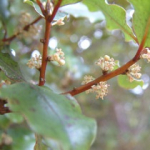 Sold Out
Sold Out
Myrsine australis, or Red Matipo, forms a handsome large shrub or tree with distinctive red branchlets and wavy leaf margins. Similar in appearance to Pittosporum tenuifolium. The cream flowers and later the black fruit are in clusters below the leaves. Used as a specimen, shrub border or hedge.
Habitat: Occurs in lowland forests. Common tree of regenerating and mature forest in coastal to montane situations.
Flowering: Spring - Summer [September - February]
Fruiting: Autumn [February - May]
Myrsine divaricata (Mapou, Weeping Matipo)
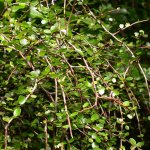
Myrsine divaricata is a small evergreen, bushy shrub, with spreading, drooping branches, which can grow to 6m high. The drooping branches give rise to woody interlacing (divaricating) branchlets bearing solitary leaves or leaves in groups. Tiny flowers, with pale yellow or red petals, occur in clusters. Evergreen.
Habitat: Found in subalpine scrub and forests, preferably where the ground is moist.
Flowering: Winter [June - November]
Fruiting: Spring - Autumn [August - April]
Olearia lineata (Small-leaved Tree Daisy)
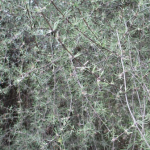
Olearia lineata is one of the best native plants for hedging with fine grey, willowy foliage. Fast growing and hardy, forming a graceful tree, bearing masses of erect twigs with clusters of small very thin leaves that are white underneath, on the margins of steep river gorges and amongst rocky outcrops. Bushy tree up to 6m tall with a fragrant white flower. Evergreen. Hardy.
Habitat: A rare, at-risk and in decline tree endemic to the South Island of New Zealand. Found mostly in the east in damper sites from lowland to 300m above sea level. Found on tussock grassland and forest margins, river terraces. Also found on the margins of steep river gorges, and amongst rock outcrops, boulder field and at the toe of alluvial fans.
Flowering: Summer [November - January]
Fruiting: Autumn [January - April]
My Lists: Rare Plants
Olearia lineata Dartonii (Twiggy Tree Daisy)
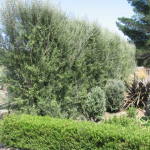
Olearia lineata Dartonii is a small, open-branched tree with plume-like branches and fine leaves. Trims well for fast hedging and shelter. Fragrant white flowers.
Flowering: Summer [December - February]
Fruiting:
Olearia paniculata (Akiraho, Golden Akeake)
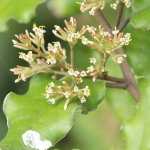
Olearia paniculata, Akiraho, is a rounded small tree with yellowish-green wavy leaves. Flowers small, white, in dense clusters. Fragrant sweet-scented flowers are borne in autumn. A good shelter plant. Hardy and tolerant of coastal conditions.
Due to its attractive appearance and hardiness, Olearia paniculata is sometimes cultivated as an ornamental shrub in gardens and landscapes. It can be utilized as a hedge, specimen plant, or included in mixed border plantings.
Habitat: Found in scrub east of East Cape to south Canterbury
Flowering: Autumn [March - May]
Fruiting: Winter [April - July]
Olearia traversii (Hakapiri, Chatham Island akeake)
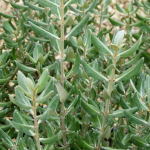
Olearia traversii is a tough, fast-growing coastal tree excellent for hedging or shelter on dry, exposed sites.
Habitat: A tree common of lowland forests, now most commonly found on dune systems. It also occurs along the edge of larger lagoons and lakes (but only in free draining soils) and sometimes on cliff tops.
Flowering: Summer [November - February]
Fruiting: Autumn [January - June]
Phebalium squameum (Satin Wood)
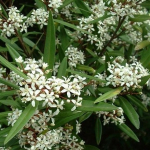
Phebalium squameum is a hardy tree that can be planted in full sun or part shade. It produces small, white, scented flowers during the spring, making it a great choice for use in hedging or as a specimen in a small garden. Once established, Phebalium squameum is tolerant of wind, coastal sites, and dry periods.
Flowering: Spring [September - November]
Fruiting:
Pittosporum eugenioides (Tarata, Lemonwood)
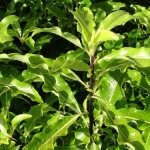
Pittosporum eugenioides, Tarata, commonly called Lemonwood, is a bushy tree ideal as a specimen or for hedging. Lemon scented foliage and fragrant flowers (spring).
Great in a windy position and also provides a barrier for the surrounding more intolerant plants. Pittosporums can be excellent stand-alone features, hedges, screens, windbreaks, shrubberies or topiary specimens. The highly ornamental, evergreen foliage almost always looks well-groomed and responds well to pruning. Frost tender when very young. Prefers a sunny to part shade position, does not mind the wind, and thrives in soil with good drainage. Tarata is somewhat drought-resistant therefore rainfall is not a major factor in its survival.
It has proved to be a great plant for establishing a quick canopy in a restoration project. It then provides an opportunity to introduce understory, shade loving plants to the same location, later planting underneath the lemonwood trees. Lemonwood is on the recommended list for replanting “small trees up to 6m.”
History of use: Maori used the gum from the bark in complex scent formula along with parts of other plants.
Habitat: Common tree of regenerating and mature forest in coastal to montane situations. It is found in forest clearings and along forest margins up to 600m above sea level.
Flowering: Spring [October - December]
Fruiting: Autumn [March - June]
My Lists: Erosion Control
Pittosporum Mountain Green
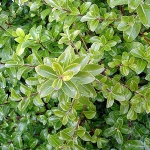 Sold Out
Sold Out
Pittosporum Mountain Green is a native evergreen that is fast becoming fashionable for its hedging and bordering appearance. With its dense glossy, lime green foliage, it offers a neutral and maintenance-free back drop to many planting plans. Best in a warm, full sun position. Evergreen. Hardy.
Flowering: Spring [September - November]
Fruiting:
Pittosporum obcordatum (Heart-leaved Kohuhu)
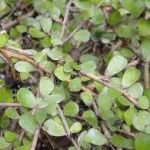 Sold Out
Sold Out
Pittosporum obcordatum is a rare, tall column shaped tree native to New Zealand. Naturally grows throughout New Zealand most commonly in eastern lowland alluvial forest favouring sites that are prone to summer drought in order to avoid water logged soils. It gets its column form form the dense interlaced twigs and branchlets that completely cover the trunk. The species has many small rounded leaves and produces small red, pink and yellow fragrant flowers in late spring. Does best in moist, fertile soil in semi-shade.
Habitat: A species of primarily eastern lowland alluvial forest, favouring sites prone to summer drought being otherwise waterlogged, and frost-prone during winter.
Flowering: Spring [September - December]
Fruiting: Summer [December - May]
My Lists: Rare Plants
Pittosporum Stephens Island
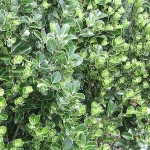
Pittosporum Stephens Island is an attractive, large growing, hardy evergreen with lime to olive green leaves. Due to its neutral colour and texture, it provides a fabulous background for many garden designs and styles. This plant maintains a neat habit, is quick growing and ideal for screening out unwanted views, noise or wind. Plant in fertile, moist but well-drained soil. Protect in colder areas from cold, drying winds. Can be planted in sun or partial shade, although leaf colour is best in sun. Evergreen. Hardy.
Pittosporum 'Stephens Island' is a form found growing on Stephens Island in the middle of Cook Strait. It has some resemblance to both Pittosporum tenuifolium and Pittosporum crassifolium (or may be a naturally occurring hybrid between P. tenuifolium and P. ralphii). It has a tidy habit with and upright medium form and will grow to a mature height of 5-10m. The small pointed foliage is smooth, blue/grey-green with a slight grey/green tomentose appearance. It adapts well to coastal conditions.
Flowering: Spring [September - November]
Fruiting:
Pittosporum tenuifolium (Kohuhu, Black Matipo)
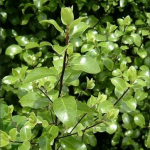
Pittosporum tenuifolium, Kohuhu, commonly called Black Matipo, is endemic and widespread throughout New Zealand. It is an extremely popular, adaptable and fast growing. Shiny light-green foliage with wavy margins and reddish brown branchlets. Fragrant dark red flowers in spring. Excellent plant for hedging and shelter. Tolerates wind, drought, frost, coastal conditions. A key species for forest revegetation and also a useful riparian edge plant. Kōhūhū grows particularly quickly at forest edges located at the bottom of high terraces. Sun or shade. Hardy. Evergreen.
The flowers’ colour ranges from dark-red to dark-purple turning almost black as the flowers age. Nectar fills the flowers. The flowers exude a honey-scented fragrance in the evenings with the scent being more obvious in slightly damp conditions. This attracts moths and night-flying insects, New Zealand’s indigenous pollinators. Fertilised flowers develop into small fruits that blacken as they ripen.
Habitat: A small tree of coastal to montane shrubland and forested habitats. Preferring successional habitats.
Flowering: Spring - Summer [October - January]
Fruiting: Autumn [February - June]
My Lists: Erosion Control
Plagianthus regius (Manatu, Lowland Ribbonwood)
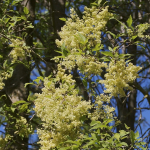
Plagianthus regius, Manatu, or Lowland Ribbonwood is a deciduous tree grown for its foliage and flowers. A profusion of small white or green flowers appears in large panicles in spring making it easier to distinguish from the similar lacebark.
Like many New Zealand native Plagianthus regius has a juvenile form that becomes a straight trunked medium to large tree. The juvenile form has bushy interlacing branches with small leaves, while an older tree will tend to have larger leaves, sometimes with the lower parts of the tree still displaying divaricating leaves.
Habitat: Coastal to lower montane. Often a prominent tree in lowland alluvial forest.
Flowering: Spring [September - November]
Fruiting: [December - January]
My Lists: Erosion Control
Podocarpus totara (Totara)
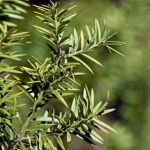
Podocarpus totara, is a classic NZ Native with needle like leaves, olive green, orange-red fruit. Bark red / brown, good shaped tree with durable timber. Tolerates wide range of sites. Evergreen. Frost tender when young.
Commonly known as Totara, trees are either male or female with the female trees having bright red, berry-like fruit in autumn. Male trees do not bear fruit. It grows with a broad and spreading habit to eventually reach 20 m tall and 10 m wide, and can be included in a medium sized garden due to its slow growth rate. Best results with this tree are achieved when it is grown in full sun on a well-drained site. It is tolerant of mild drought, frost, cool climates, some wind, and coastal environments. Totara is commonly included in a mixed planting in a large garden, used in native plantings, or grown as a specimen.
Habitat: Widespread and at times abundant tree of lowland, montane and lower subalpine forest. May also form a vegetation type in which it is the dominant species.
Flowering: Spring [October]
Fruiting: Autumn [March - May]
Pseudopanax arboreus (Whauwhaupaku, Fivefinger)
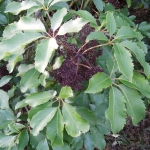
Pseudopanax arboreus, commonly called Fivefinger, is one of New Zealand's most common native trees found from Cape Reinga to Bluff in lowland forests. Its particular form of a glossy, five to seven fingered leaf along with quick and luxuriant growth. It grows into a small stout tree up to 5 metres high and grows well in most soils and situations. Fast growing with small purplish black berries in autumn.
History of use: New Zealand Beekeepers Magazine rates Pseudopanax arboreus as a star performer for food for bees. The trees provide abundant pollen and copious, rich nectar very early in the season when few other species are in flower (from June to August). Plant in good numbers clustered together to amplify the availability of flowers for bee feed. Bees love the small scented green flowers that are followed by bunches of dark purple fruits enjoyed by birds from August to February. Flower buds can be easily mistaken for ripe fruit whereas clusters of fruit are actually ripe one year after flowering.
Habitat: Coastal to montane. Moist broadleaf forest. Frequently epiphytic. A frequent component of secondary forest and forest margins. Tolerant of moderate frosts and coastal conditions but should be sheltered from strong winds.
Flowering: Winter [June - August]
Fruiting: Spring - Summer [August - February]
My Lists: Winter Pollen
Pseudopanax crassifolius (Horoeka, Lancewood)
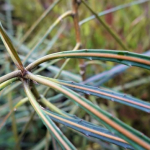
Pseudopanax crassifolius, commonly known as Lancewood or Horoeka, is a species of evergreen tree that is native to New Zealand. It belongs to the family Araliaceae and is known for its unique growth habit and distinctive foliage.
Lancewood typically grows to a height of 3 to 10 meters, though it can reach up to 15 meters in favorable conditions. It has a slender, erect trunk that is often unbranched for several meters, giving it a distinctive lance-like appearance. The trunk is smooth and grayish-brown in color, and it is often marked with vertical ridges or scars from fallen leaves.
The leaves of Pseudopanax crassifolius are leathery and glossy, with a lanceolate shape that tapers to a point. They are typically dark green in color and can measure up to 60 centimeters in length. The margins of the leaves are serrated or toothed, which adds to their distinctive appearance.
One of the most striking features of Pseudopanax crassifolius is its ability to change its leaf shape as it matures. Young Lancewood trees have long, narrow leaves with serrated margins, while older trees develop larger, broader leaves with smooth margins. This unique leaf morphology has earned it the nickname "lancewood" due to its resemblance to a lance or spear.
Pseudopanax crassifolius produces small, inconspicuous flowers that are typically green or cream-colored. The flowers are arranged in clusters and are followed by small, fleshy fruit that ripens to a dark purple or black color. The fruit is an important food source for native birds in New Zealand.
Lancewood is a hardy plant that is well-adapted to New Zealand's coastal and lowland forests. It can tolerate a wide range of soil types, but prefers well-drained soils. It is a slow-growing species and can take many years to reach maturity.
In addition to its unique appearance, Pseudopanax crassifolius has cultural significance for the Māori people of New Zealand, who have traditionally used its wood for various purposes, including weapons, tools, and construction. Today, it is also a popular ornamental plant in gardens and landscapes, prized for its distinctive foliage and architectural form.
Habitat: Lowland to montane forest. Sealevel to 750 m
Flowering: Summer - Autumn [January - April]
Fruiting: Autumn [January - April]
My Lists: Pioneer Species
Pseudopanax ferox (Horoeka, Toothed Lancewood)
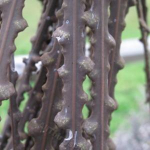
Pseudopanax ferox, Toothed or Fierce Lancewood, is a spectacular slow-growing specimen with narrow, down pointing saw-like brown very tough juvenile leaves that have irregular blunt bumps along the edge. Once the slow-growing tree reaches maturity at 10 to 15 years, the leaf form becomes shorter, wider and dark green in colour. It is only in adulthood that the tree's shape changes from one central stem and has downward growing leaves to a more typical tree shape with branches spreading to build a round head. A mature toothed lancewood can reach 6 metres height with a trunk of up to 25 cm in diameter.
Habitat: Coastal to subalpine (10-800 m a.s.l.) on consolidated sand dunes (dune forest), in grey scrub overlying pumice, on recent alluvial (coarse gravels), limestone outcrops, boulder fall, cliff faces, talus slopes and scarps. Also found as a sparse component of seasonally drought-prone but otherwise cold and wet alluvial forests. This species prefers drier habitats and conditions than P. crassifolius.
Flowering: Summer [November - April]
Fruiting: Autumn [December - June]
Pseudowintera colorata (Horopito, Pepper Tree)
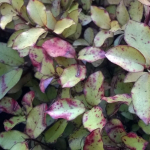 Sold Out
Sold Out
Pseudowintera colorata is endemic and found throughout the country in coastal to montane areas. It is often found in heavily browsed forests and therefore not threatened. Unpalatable to browsers due to its peppery leaves. Pseudowintera colorata is evergreen and likes moist soil rich in organic matter.
Habitat: Coastal, lowland, or montane forest margins and shrubland.
Flowering: Summer [November - March]
Fruiting: Autumn [December - June]
Sophora microphylla (South Island Kowhai)
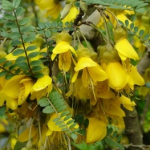
Sophora microphylla is also known as South Island Kōwhai, having showy yellow flowers in early spring. This particular Kōwhai has very small leaves (microphylla) and a tangled juvenile form, tending to straighten up and grow from an upright trunk at about four years. Kōwhai makes a good garden tree and is necessary for revegetation projects as a bird attractor. Kōwhai are suited to upper bank plantings of riparian areas. They also make beautiful shade or specimen trees. Semi-deciduous. Hardy.
Sophora microphylla have horn-shaped yellow flowers. The nectar is a favourite food for Tui, Bellbird and Kererū which also eat the leaves. The seed pods which appear after flowering stay hanging on the tree through winter.
Kōwhai is the national flower of New Zealand.
Habitat: In the North Island, especially the northern half this is a species of mainly riparian forest. South of Hamilton it can be found in a diverse range of habitats from coastal cliff faces and associated wetlands to inland grey scrub communities. Sophora microphylla and Sophora prostrata are the only forms naturally existing in Canterbury.
Flowering: Winter [August - October]
Fruiting: Spring - Summer [October - May]
My Lists: Winter Pollen
Sophora tetraptera (North Island Kowhai)
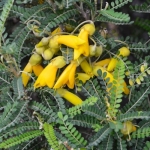
Sophora tetraptera is commonly known as the North Island Kowhai or large-leaved Kowhai that grows naturally only in the central east of the North Island. It has larger, more widely spaced leaves than other species. It is a great specimen to provide some contrast in a strictly native garden with its early abundance of yellow flowers in early spring which are a favourite food of the Tui and other bird life. Frost tender when young,
Habitat: Widespread and common from coastal forested habitats inland along rivers and within associated low scrub and forest. Common around lake margins (especially Lake Taupo) and on ignimbrite cliffs bordering the upper Waikato River. Although a primarily lowland species it can occur in montane riparian forests.
Flowering: Winter - Spring [July - October]
Fruiting: Spring - Summer [October - May]
Thuja occidentalis Smaragd (Emerald Cedar)
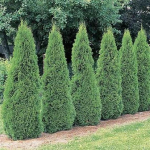
Thuja occidentalis Smaragd, commonly known as Emerald Green Arborvitae, is a cultivar of Thuja occidentalis, a coniferous evergreen tree from the family Cupressaceae. Smaragd is a popular and widely cultivated cultivar known for its distinct appearance and landscaping uses.
Smaragd is a compact, slow-growing evergreen tree that has a narrow, columnar shape with dense branching, forming a symmetrical, pyramid-like silhouette. The foliage is arranged in flattened sprays that are scale-like and tightly packed, giving the tree a fine-textured, feathery appearance.
The foliage of Smaragd is its most distinctive feature. The scale-like leaves are emerald green in color, hence the cultivar name "Smaragd," which means "emerald" in German. The foliage retains its color throughout the year, providing year-round interest in the landscape. When crushed, the leaves release a pleasant aroma.
Smaragd produces small, inconspicuous cones that are about 0.5 inches (1.3 cm) long and initially green, but turn brown as they mature. The cones are typically hidden deep within the foliage and are not a prominent feature of the tree.
Smaragd has a slow to moderate growth rate, making it relatively low-maintenance compared to other evergreen trees. It prefers full sun to partial shade and well-drained, moist soil. Once established, it is drought-tolerant and can withstand a wide range of soil conditions. Smaragd is generally resistant to pests and diseases, although it may be susceptible to some fungal diseases in humid conditions.
Due to its compact size, narrow form, and attractive emerald green foliage, Smaragd is a popular choice for hedges, screens, and foundation plantings. It can also be used as a focal point in small gardens, rock gardens, or as a specimen tree in larger landscapes. Smaragd is commonly used in urban and suburban landscapes for its year-round green color and low-maintenance requirements.
Overall, Thuja occidentalis Smaragd is a versatile, slow-growing evergreen tree with a distinctive emerald green foliage, making it a popular choice for landscaping projects where a compact, columnar form and year-round green color are desired. Evergreen. Hardy.
Notice: Taking orders now for summer delivery
